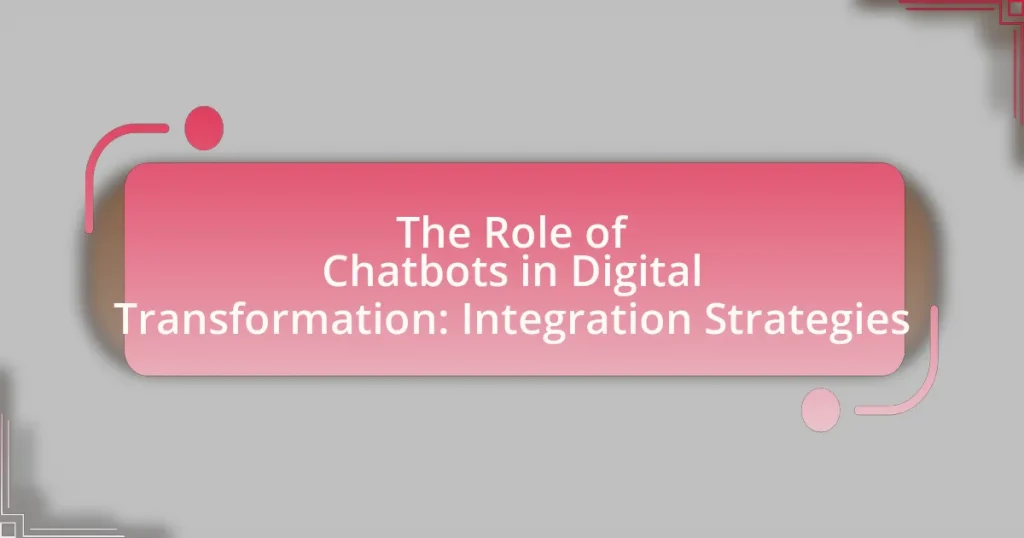Chatbots are integral to digital transformation, enhancing customer engagement and operational efficiency across various industries. They provide instant responses to inquiries, automate repetitive tasks, and facilitate data collection, which collectively improve user experience and satisfaction. The article explores the role of chatbots in digital transformation initiatives, detailing their functionalities, integration strategies, and the challenges businesses may face during implementation. Additionally, it discusses future trends, including advancements in artificial intelligence and user expectations, while offering best practices for optimizing chatbot performance and measuring success.

What is the Role of Chatbots in Digital Transformation?
Chatbots play a crucial role in digital transformation by enhancing customer engagement and streamlining operations. They provide instant responses to customer inquiries, which improves user experience and satisfaction. According to a report by Gartner, by 2022, 70% of customer interactions were expected to involve emerging technologies like chatbots, indicating their growing importance in business strategies. Furthermore, chatbots can automate repetitive tasks, allowing human employees to focus on more complex issues, thus increasing overall efficiency. This integration of chatbots into business processes exemplifies how organizations can leverage technology to adapt to changing market demands and improve service delivery.
How do chatbots contribute to digital transformation initiatives?
Chatbots significantly contribute to digital transformation initiatives by enhancing customer engagement and streamlining operational efficiency. They provide instant support and personalized interactions, which improve user experience and satisfaction. According to a report by Gartner, organizations that implement chatbots can reduce operational costs by up to 30% through automation of routine tasks. This automation allows businesses to allocate resources more effectively, driving innovation and agility in their digital transformation efforts. Furthermore, chatbots facilitate data collection and analysis, enabling organizations to gain insights into customer behavior and preferences, which is crucial for informed decision-making in a digital landscape.
What are the key functionalities of chatbots in this context?
The key functionalities of chatbots in the context of digital transformation include automating customer service, providing instant responses, and facilitating data collection. Automating customer service allows businesses to handle inquiries efficiently, reducing response times and operational costs. Providing instant responses enhances user experience by ensuring that customers receive immediate assistance, which is crucial in a fast-paced digital environment. Additionally, chatbots facilitate data collection by gathering user interactions and preferences, enabling businesses to analyze customer behavior and improve services. These functionalities are supported by the increasing adoption of AI technologies, which enhance the capabilities of chatbots in understanding and responding to user queries effectively.
How do chatbots enhance customer engagement during digital transformation?
Chatbots enhance customer engagement during digital transformation by providing instant, personalized interactions that improve user experience. They facilitate 24/7 availability, allowing customers to receive immediate responses to inquiries, which increases satisfaction and retention rates. According to a study by Gartner, by 2022, 70% of customer interactions will involve emerging technologies such as chatbots, indicating their growing importance in customer engagement strategies. Additionally, chatbots can analyze customer data to tailor responses and recommendations, further fostering a sense of connection and relevance for users.
Why are chatbots becoming essential in modern businesses?
Chatbots are becoming essential in modern businesses due to their ability to enhance customer service and streamline operations. They provide 24/7 support, allowing companies to respond to customer inquiries instantly, which improves customer satisfaction and retention. According to a report by Gartner, by 2022, 70% of customer interactions were expected to involve emerging technologies like chatbots, highlighting their growing importance in customer engagement strategies. Additionally, chatbots can handle a high volume of inquiries simultaneously, reducing the workload on human agents and lowering operational costs. This efficiency not only improves service delivery but also allows businesses to allocate resources more effectively.
What trends are driving the adoption of chatbots?
The primary trends driving the adoption of chatbots include advancements in artificial intelligence, increasing consumer demand for instant support, and the need for cost-effective customer service solutions. Artificial intelligence technologies, such as natural language processing and machine learning, have significantly improved chatbot capabilities, enabling them to understand and respond to user queries more effectively. According to a report by Gartner, by 2025, 75% of customer service interactions will be powered by AI, highlighting the growing reliance on chatbots for efficient customer engagement. Additionally, consumers increasingly expect immediate responses, pushing businesses to implement chatbots to meet these expectations. Furthermore, the cost-effectiveness of chatbots allows companies to reduce operational costs while enhancing customer experience, making them an attractive solution for businesses undergoing digital transformation.
How do chatbots improve operational efficiency?
Chatbots improve operational efficiency by automating routine tasks and providing instant responses to customer inquiries. This automation reduces the workload on human employees, allowing them to focus on more complex tasks that require human intervention. For instance, a study by IBM found that chatbots can handle up to 80% of routine customer service interactions, significantly decreasing response times and operational costs. Additionally, chatbots can operate 24/7, ensuring that customer queries are addressed promptly, which enhances overall productivity and customer satisfaction.

What are the Integration Strategies for Chatbots?
Integration strategies for chatbots include API integration, platform integration, and data integration. API integration allows chatbots to connect with various services and applications, enabling seamless communication and data exchange. For instance, integrating with customer relationship management (CRM) systems enhances customer interactions by providing real-time data access. Platform integration involves deploying chatbots on messaging platforms like Facebook Messenger or WhatsApp, which broadens user reach and engagement. Data integration ensures that chatbots can access and utilize data from multiple sources, improving their ability to provide personalized responses. These strategies collectively enhance the functionality and effectiveness of chatbots in digital transformation initiatives.
How can businesses effectively integrate chatbots into their existing systems?
Businesses can effectively integrate chatbots into their existing systems by utilizing APIs to connect the chatbot with current software platforms. This integration allows for seamless data exchange and enhances user experience by providing real-time responses. For instance, a study by Gartner indicates that by 2022, 70% of customer interactions will involve emerging technologies like chatbots, demonstrating their growing importance in operational efficiency. Additionally, businesses should ensure that chatbots are trained on relevant data from their existing systems to improve accuracy and relevance in responses, thereby increasing customer satisfaction and engagement.
What are the best practices for chatbot integration?
The best practices for chatbot integration include ensuring seamless connectivity with existing systems, prioritizing user experience, and implementing robust analytics for performance tracking. Seamless connectivity allows chatbots to access and utilize data from various platforms, enhancing their functionality and relevance. Prioritizing user experience involves designing intuitive interactions that meet user needs, which can lead to higher engagement and satisfaction rates. Implementing robust analytics enables organizations to monitor chatbot performance, identify areas for improvement, and optimize interactions based on user behavior and feedback. These practices are supported by industry studies indicating that effective integration can significantly enhance customer engagement and operational efficiency.
How do APIs facilitate chatbot integration with other platforms?
APIs facilitate chatbot integration with other platforms by providing standardized protocols that enable communication between different software systems. This allows chatbots to access external data and services, enhancing their functionality and user experience. For instance, APIs can connect chatbots to customer relationship management (CRM) systems, enabling them to retrieve customer information in real-time, which improves service personalization. Additionally, APIs support the integration of chatbots with messaging platforms like Facebook Messenger or Slack, allowing seamless interaction across various channels. This interoperability is crucial for businesses aiming to streamline operations and improve customer engagement through digital transformation.
What challenges might businesses face during chatbot integration?
Businesses may face several challenges during chatbot integration, including technical compatibility, user adoption, and data privacy concerns. Technical compatibility issues arise when existing systems and platforms do not seamlessly integrate with the new chatbot technology, leading to potential disruptions in service. User adoption challenges occur when employees or customers resist using the chatbot due to unfamiliarity or perceived inefficiency, which can hinder the overall effectiveness of the integration. Additionally, data privacy concerns are significant, as businesses must ensure that the chatbot complies with regulations such as GDPR, which mandates strict guidelines on user data handling. These challenges can impede the successful implementation of chatbots, affecting the overall digital transformation strategy.
How can organizations overcome resistance to chatbot adoption?
Organizations can overcome resistance to chatbot adoption by implementing comprehensive training programs and demonstrating the value of chatbots through pilot projects. Training equips employees with the necessary skills to interact with chatbots effectively, addressing fears of job displacement and enhancing user confidence. Pilot projects allow organizations to showcase tangible benefits, such as improved customer service metrics and increased efficiency, which can help to alleviate skepticism. Research indicates that organizations that actively involve employees in the chatbot implementation process experience a 30% higher acceptance rate, as employees feel more invested in the technology.
What technical issues should be addressed during integration?
During integration, key technical issues that should be addressed include data compatibility, API integration, security protocols, and system scalability. Data compatibility ensures that different systems can communicate effectively, which is crucial for seamless operations. API integration is vital for enabling various software applications to work together, allowing chatbots to access necessary data and functionalities. Security protocols must be implemented to protect sensitive information during data exchange, as breaches can lead to significant risks. Finally, system scalability is essential to accommodate future growth and increased user demand, ensuring that the integration can handle higher loads without performance degradation. Addressing these issues is critical for successful chatbot integration in digital transformation initiatives.

What are the Future Trends for Chatbots in Digital Transformation?
Future trends for chatbots in digital transformation include increased integration with artificial intelligence, enhanced personalization, and the adoption of multi-channel capabilities. As organizations seek to improve customer engagement, chatbots will leverage AI to provide more accurate responses and predictive analytics, allowing for tailored interactions based on user behavior. According to a report by Gartner, by 2025, 75% of customer service interactions will be powered by AI, indicating a significant shift towards automated solutions. Additionally, the rise of omnichannel strategies will see chatbots functioning seamlessly across various platforms, ensuring consistent user experiences. This evolution reflects the growing importance of chatbots in streamlining operations and enhancing customer satisfaction in the digital landscape.
How will advancements in AI impact the role of chatbots?
Advancements in AI will significantly enhance the role of chatbots by enabling them to understand and respond to user queries with greater accuracy and context. Improved natural language processing (NLP) capabilities will allow chatbots to interpret nuances in human language, leading to more meaningful interactions. For instance, AI-driven chatbots can analyze user sentiment and intent, which enhances their ability to provide personalized responses. According to a report by Gartner, by 2025, 75% of customer service interactions will be powered by AI, indicating a shift towards more intelligent and efficient chatbot systems. This evolution will not only streamline customer service processes but also improve user satisfaction and engagement.
What new features can we expect in future chatbot technologies?
Future chatbot technologies are expected to incorporate advanced natural language understanding, enabling more nuanced and context-aware interactions. These improvements will allow chatbots to better interpret user intent and respond appropriately, enhancing user experience. Additionally, integration with machine learning algorithms will facilitate personalized interactions based on user behavior and preferences, making conversations more relevant. Furthermore, the incorporation of multimodal capabilities, such as voice and visual inputs, will enable chatbots to engage users through various channels, improving accessibility and user engagement. These advancements are supported by ongoing research in AI and machine learning, which consistently demonstrates the potential for enhanced conversational agents in real-world applications.
How will user expectations evolve regarding chatbot interactions?
User expectations regarding chatbot interactions will evolve towards a demand for more personalized, context-aware, and seamless experiences. As artificial intelligence and natural language processing technologies advance, users will increasingly expect chatbots to understand their preferences, history, and specific needs, leading to more tailored interactions. Research indicates that 70% of consumers prefer chatbots for quick communication with brands, highlighting the importance of efficiency and responsiveness in user expectations. Furthermore, as users become accustomed to high-quality interactions with advanced AI systems, they will expect chatbots to handle complex queries and provide accurate, relevant information without human intervention. This shift will necessitate continuous improvements in chatbot capabilities to meet rising user demands for sophistication and reliability.
What are the best practices for optimizing chatbot performance?
To optimize chatbot performance, implement continuous training and user feedback integration. Continuous training involves regularly updating the chatbot’s knowledge base with new information and user interactions, which enhances its ability to understand and respond accurately. User feedback integration allows for the collection of insights on user satisfaction and areas for improvement, enabling targeted adjustments to the chatbot’s responses and functionalities. Research indicates that chatbots that undergo regular updates and incorporate user feedback can improve user engagement by up to 30%, demonstrating the effectiveness of these practices in enhancing performance.
How can businesses measure the success of their chatbots?
Businesses can measure the success of their chatbots through key performance indicators (KPIs) such as user engagement, resolution rates, and customer satisfaction scores. User engagement can be quantified by tracking metrics like the number of interactions per session and the frequency of return users, which indicate how effectively the chatbot captures user interest. Resolution rates reflect the percentage of inquiries successfully handled by the chatbot without human intervention, providing insight into its efficiency and effectiveness. Customer satisfaction scores, often gathered through post-interaction surveys, offer direct feedback on user experience and satisfaction levels. According to a study by Gartner, organizations that implement effective chatbot strategies can achieve a 70% reduction in customer service costs, highlighting the financial impact of successful chatbot deployment.
What strategies can enhance user experience with chatbots?
To enhance user experience with chatbots, implementing personalization strategies is essential. Personalization allows chatbots to tailor interactions based on user preferences, history, and behavior, leading to more relevant and engaging conversations. Research indicates that 80% of consumers are more likely to make a purchase when brands offer personalized experiences. Additionally, ensuring natural language processing capabilities improves understanding and responsiveness, which can significantly reduce user frustration. A study by Salesforce found that 69% of consumers prefer chatbots for quick communication with brands, highlighting the importance of efficiency in chatbot design. Furthermore, integrating feedback mechanisms enables continuous improvement, as user insights can guide updates and refinements to the chatbot’s functionality.










